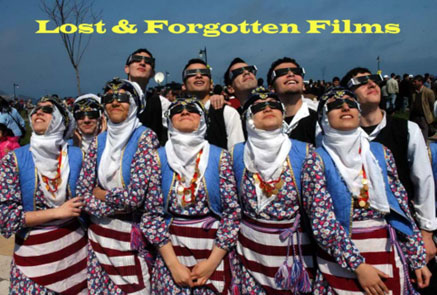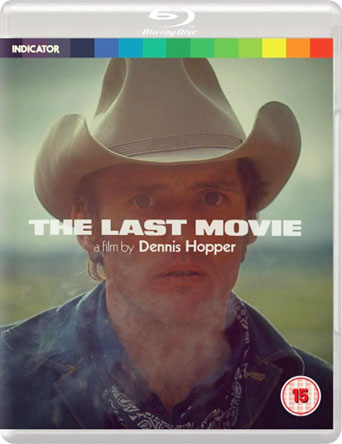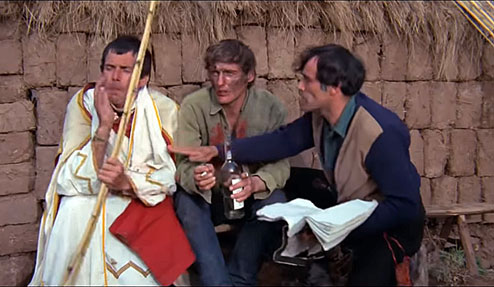Iconic, bizarre or just plain ‘weird’ – Part One
Alan Dearling

Way back in my personal life and times, I watched one heck of a lot of films. You might say that I ‘consumed them’ and along with music – was consumed by them. I wasn’t on the Film Studies course at uni in Canterbury, but I must have been close to achieving a one hundred per cent attendance at film showings. Old films from the beginnings of cinema such as the Russian films of Sergei Eisenstein like ‘Battleship Potemkin’; DW Griffith’s ‘Birth of a Nation’, ‘Nosferatu’ by FW Murnau, and on to Kurosawa’s ‘Seven Samurai’ and ‘Rashomon’; Luis Bunuel and Salvador Dali with ‘Chien Andalou’ and ‘L’Age d’Or’ and the New Wave European films of Pasolini such as ‘Theorem’ and ‘Pigsty’, Fellini’s ‘Satyricon’ and ‘La Dolce Vita’, Werner Herzog’s ‘Fitzcarraldo’ alongside other films with actor/adversary, Klaus Kinski, plus Godard’s surreal works including ‘Week End’ and ‘Contempt’. These are just a few of the many, many…
And America was in for a renaissance in film-making led by younger, ambitious and experimental film directors who became as big as the ‘stars’ of Hollywood. They were a mixed bag from a range of backgrounds. William Friedkin, Roman Polanski, Jack Nicholson and Dennis Hopper – all actors who turned their hands to directing. George Lucas was a great innovator before he became the go-to creator of blockbusters. Likewise, Francis Ford Coppola, though his first film, ‘Dementia 13’ for producer, Roger Corman is best forgotten.
So, this is my little effort to share some of the films that disappeared, and some of those that ‘escaped’ from both the cinema circuits, but can just about be found on dvd and blu-ray, often in lovingly recreated and mastered versions.
Here are my first offerings. There are few more to come in the future. Hope you’ll find your film-consuming appetite whetted!
********************************************************************************
The Shooting (1966)
Filmed in the desert and mountain-scapes of Utah, this was a co-production between actor, Jack Nicholson and Monte Hellman. They actually shot two films over six weeks funded by cult horror director, Roger Corman, using adjacent locations and a number of the same actors. Both were westerns. The second was ‘Ride in the Whirlwind’ again featuring Jack Nicholson and Millie Perkins. Neither film was distributed until 1968 and even then on a very limited basis. The films were publicised on the back of ‘Easy Rider’, because of Nicholson’s involvement. But in fact Jack was in a relatively minor yet pivotal role as the smirking, smiling ghoul of a hired gunfighter, dressed appropriately in black – Billy Spear. He is indeed extremely fast on the draw.

Enigmatic, sometimes verging on the incomprehensible, it’s more of a mood poem. Brooding. A western-styled, ‘Waiting for Godot’ came to mind. The dialogue is limited, the director concentrates on naturalistic light and dark, creating moods of scowling darkness. Horses die, a mysterious un-named young woman (Perkins) commands the protagonists on a quest, a journey – a revenge hunt to kill. An unusual female lead role that is assertive, but not especially likeable. And she appears to be being abetted by Nicholson’s character, who is the man of mystery, the archetypal man in black. There are many interesting examples of experimental camera work with scene framing, cutting to black, and allowing the action to move into the frame, rather than panning along with the action. Like many of the films of new American sixties it was hallucinatory. “Your brains are going to fry out here!” is almost an appeal to the audience to join in the strangeness. Warren Oates develops a solid role as Gashade, somewhat reminiscent of James Coburn.
David Pirie in ‘Time Out’ wrote:
“Probably the first Western which really deserves to be called existential… Hellman builds remorselessly on the atmosphere and implications of the ‘quest’ until it assumes a terrifying importance in itself… What Hellman has done is to take the basic tools of the Western, and use them, without in anyway diluting or destroying their power, as the basis for a Kafkaesque drama.”
Much of the final section of ‘The Shooting’ is bleached out, almost to a blinding ‘whiteness’. There seem to be a number of endings and they are quirky and unexpected. It’s by no means perfect. Often clunky in fact, with uneven acting, odd humour and sense of anomie and bleakness. The dvd copy I bought seems to have a character on the right of the cover who is not even in the film! But, it’s worth searching out as a missing link in the cinema-chain that connects the New American cinema with the more art-house school film movement in Europe.
Trailer for ‘The Shooting’: https://www.dailymotion.com/video/x2xliqi
Later in his career, Nicholson tried his hand at directing with ‘Drive He Said’ (1971); ‘Goin’ South’ (1978) and ‘The Two Jakes’ (1990).
The Last Movie (1971)
Dennis Hopper was bank-rolled by Universal Studios to create and direct pretty much any film he wanted after the phenomenal success of ‘Easy Rider’. But the studio didn’t anticipate the potage of weirdness that Hopper eventually created in the editing room – probably from dozens of hours of film and definitely a lot of edits/versions/recreations and screenings and advice from a seemingly endless stream of friends and fellow directors, musos, drug-experimenters. It is one the most flawed yet fascinating films ever made. Film-maker, Alejandro Jodorowsky was one of them and perhaps, Nicholas Ray.

It turned out to be monumental in scale and catastrophic in terms of meanderings into madness and beyond. Dennis Hopper was most definitely paranoid, experiencing drug and alcohol induced delusions. Cocaine, LSD and marijuana were in plentiful supply amongst the crew and actors. It was Hopper’s aim to produce the ultimate American Art movie. He saw himself in terms of being ‘James Dean’, being a genius. To his friends, especially women, he was violent, dangerous. He imbued his character, Kansas, a horse-wrangler for the western being created inside the film, as the ultimate outcast, much more sinned against than sinning. Narcissistic. Unstable and unhinged. But at the same time, Kansas and the film is a remarkable parable for all that was wrong in America, its nightmares, hang-ups, violence, bigotry, nationalism and misogyny. Yet Maria (excellently played by Stella Garcia), who is Kansas’s local lover in the film, is also almost without scruples. On seeing a dead man on the bonnet of a car, she exclaims: ‘So? He looked dead. I didn’t know him.’ Life is cheap or even worthless. She wants and demands the rewards of consumerism: a swimming pool, an electric fridge and a mink coat. ‘The Last Movie’ is stuffed full of drugs. Hallucinations, dreams, violence, erotic sex…it’s ‘Apocalypse Now’ without Brando and Kurtz. But, it is cut from the same cloth.
It was intended to film in Mexico, but the Mexican government wanted editorial control and censorship. ‘No Way, Jose!’ Instead Dennis chose to take his extensive cast of freaks to a location 12,800 feet up in the Andes in Peru. The script by Stewart Stern (who had scripted ‘Rebel without a Cause) was disembowelled by Hopper, though it is essentially a film about the making of a western film about the death of Billy the Kid. Much of the content was improvised. It was an imitation of the movies imitating movies, imitating real life. The opening sequences of the Catholic parade, with a be-thorned Jesus, strange framing, hand-held action was shot for real in a specially-created version of the local ceremony sanctioned by the local priest. The padre in the film and the actor playing him, Tomas Milian, was embroiled by Hopper into a set of complex ethical and moral mazes (and alcohol and drugs!). This is insanity, film-making at the edges of darkness. Much of the action is set around the Church of Didymos Judas Thomas, with lush, violent set pieces incandescent with music, fire, mayhem and film-making of the western action movie and ‘The Last Movie’, filmed around the central square of the Peruvian town, known as Chinchero. Many locals were extras. They had never seen a film, much less been involved in making one. A complex one that was reflecting their own cultures and the cultural collision within and without in the USA.

Kris Kistofferson sings the earliest version of ‘Me and Bobby McGee’ along with stoned friends including Michelle Phillips from the Mamas and Papas and John Buck Wilkin, Peter Fonda and more. The drugs, alcohol, the sex and at least some of the brutal violence is very much for ‘real’. There’s a lot of music, recorded on location ‘live’ – from the US and Peru. It interweaves into pastoral landscapes, waterfalls, horses, shootings and ultra-violence.
It’s ultimately a film about films. A film about contrasting views of ‘realities’. Separate conflicting states of consciousness. A film about behaviour, morality and hypocrisy. The movie itself, the location in Peru and its people, and movie-making as an allegory of self-destruction. ‘Cut, cut, cut’, we hear the director of the western, Sam Fuller, cry out and we see ‘Scene Missing’ cue cards flash across the screen. It amazes, frustrates, mesmerises. It’s erotic, worrisome, confusing, muddled but also magnificent in its breadth, filmic beauty and some totally audacious sequences such as the long panning shot of three parties in three separate rooms in one house who are celebrating the end of the western film-shoot, with different music, activities unfolding to the camera and microphones – you can hear the music, the sounds, you can see the people and you can almost smell the marijuana, the splashing of alcohol and the culture clashes between the different actors, crews and the worlds of the USA and Peru.
It’s a perfect example of ‘personal freakdom’. Insanity. As the actor proclaims in a toast in one sequence: ‘To whores and whorehouses!’ And Sam Fuller yells, ‘I want balls when you die!’ A visual feast, a nightmare and a requiem.
Trailer for ‘The Last Movie’ 4k restoration: https://www.youtube.com/watch?v=E7038IZw_MQ
There is even a full length documentary entitled ‘The American Dreamer’ (1971) directed by L. M. Kit Carson and Lawrence Schiller which peeks into the tortured editing of ‘The Last Movie’ by Hopper: https://www.youtube.com/watch?v=SHq6FwPn_bg
Dennis Hopper died in 2010 but did get a chance to direct again later in his career with films including: ‘Out of the Blue’ (1980) and ‘Colors’ (1988).

A very welcome series in these times of wretched streaming services with such a limited choice. I do hope you’ll be covering Kevin Brownlow’s films It Happened Here and Winstanley. And any tips about how to see some of those great Cuban films would also be welcome.
Comment by Tim on 9 July, 2023 at 6:40 am